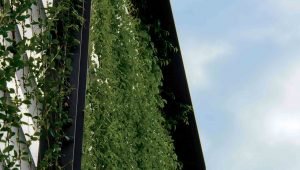Key Factors for Success with Green Walls, Vertical Gardens and Facades – Ronstan Architectural outlines how to ensure a successful growth.
 Green walls are increasing in popularity as we learn of their benefits in amenity and thermal control. But success is not as simple as selecting a plant and popping it in the ground or bed. Ultimately, a vertical garden will be judged long after its installation, so factors over and above the right support structure, careful analysis, and good site execution are required. For example, a well documented maintenance plan that is understood by both builder and building owner alike is critical.
Green walls are increasing in popularity as we learn of their benefits in amenity and thermal control. But success is not as simple as selecting a plant and popping it in the ground or bed. Ultimately, a vertical garden will be judged long after its installation, so factors over and above the right support structure, careful analysis, and good site execution are required. For example, a well documented maintenance plan that is understood by both builder and building owner alike is critical.
Success essentially comes down to three key areas:
Climatic.
As simple as it may seem we need to understand the site. The availability of sunlight and the potential for overshadowing are both critical. Wind tunnels can develop in city streets. Reflective surfaces of many CBD environments can lift the average mean temperature of the green wall several degrees higher than a city average. Both challenge local species and careful site analysis is a must.
Species.
Understand the purpose of the facade. Is it for aesthetics, screening, or thermal control? Leaf density is a key variable, but leaf colour and scent often take precedence. How and when the plants grow, deciduous or evergreen, fruit or flowers, and known pests all seem fundamental considerations, but impact on performance and maintenance.
Facade Design.
With species selected, the facade must be designed around the plants. How much room the plant needs, its proximity to the wall (on or off the face), its growth patterns and future dead weight, leaf density and wind loads, all affect the support structure design.
Ronstan Tensile Architecture understands the key design considerations for climbing plants. Contact Ronstan to assist with all aspects of your next green facade project.